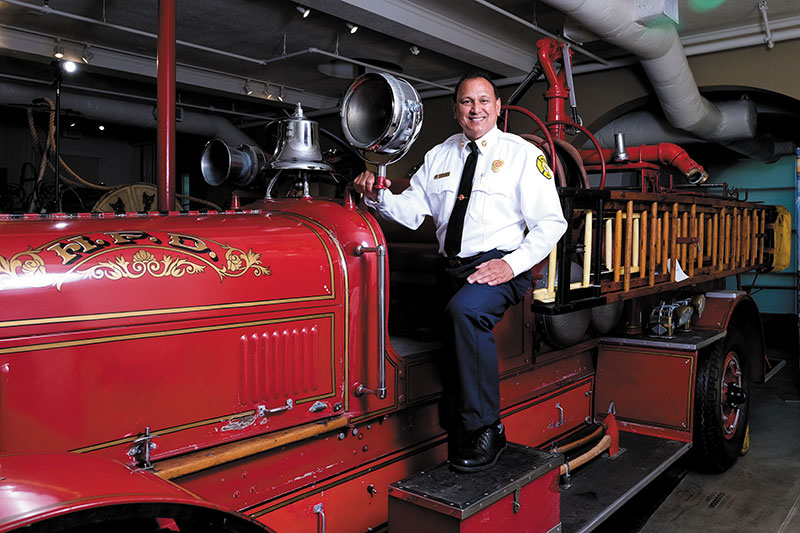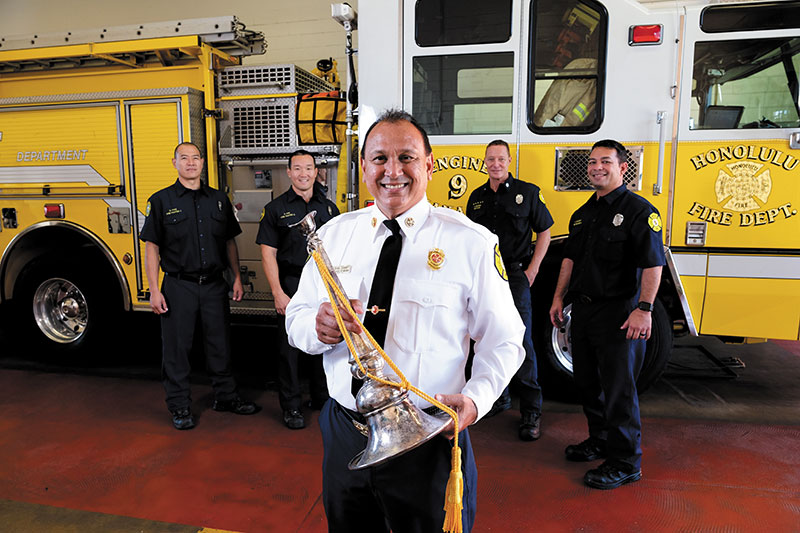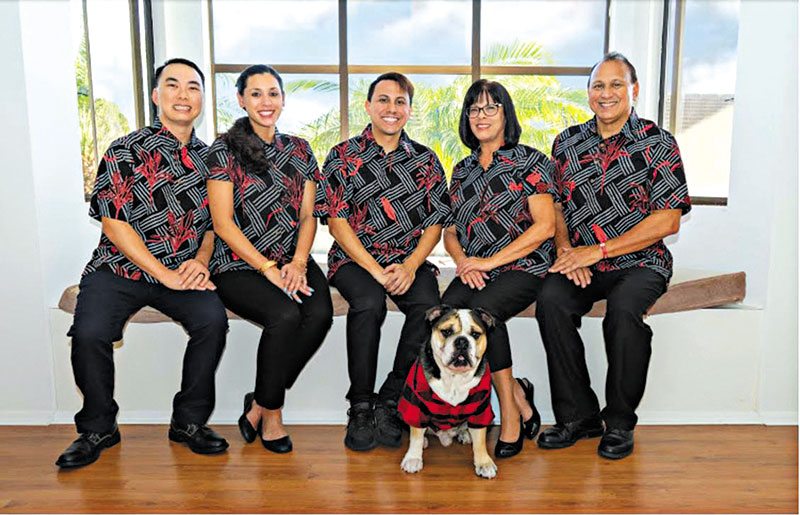Man On Fire

Honolulu Fire Department fire chief Manuel Neves takes a seat on a1928 Hose Wagon Apparatus 7.
Fire chief Manuel Neves has been on a hot streak since he took the helm of Honolulu Fire Department in 2013 and began making improvements — and he’s only getting started.
BY JAIMIE KIM FARINAS
It was on Jan. 11, 1851 — just shy of exactly 169 years ago — that King Kamehameha III established Honolulu Fire Department, making it the oldest agency of its kind in the U.S. west of the Mississippi.
To be sure, it’s a foresight that has had a profound impact on the island.
Today, HFD has roughly 1,100 firefighters spread out among 43 stations, which house 65 fire companies and 69 frontline fire trucks. Annually, its public servants respond to about 80,000 alarms that run the gamut of fire, medical, rescue and hazmat emergencies.

Honolulu Fire Department fire chief Manuel Neves, firefighter bugle in hand, poses in front of Fire Engine 9 with (from left) firefighter 1 Mark Pang, firefighter 3 Peter Kim, Capt. Trevor Wilson and firefighter 1 Aaron Bangan.
So to say that HFD has left an indelible mark on O‘ahu would be quite the understatement — which Manuel Neves understands all too well.
Appointed fire chief in 2013, the Damien Memorial School alumnus has made it his mission of sorts to pay homage to his department’s storied history. Neves’ administration was the first, for instance, to open an existing museum within its 636 South St. headquarters in Kaka‘ako.
And it’s the past that Neves continues to draw inspiration from for all he aspires to accomplish during his tenure at the helm of one of the largest fire departments in the U.S.
“That’s one of my objectives: to make sure that we stand on the shoulders of those folks that came before us and made us one of the best fire departments in the country,” says Neves, HFD’s 34th fire chief. “My time here is just as a steward of the small, little portion of this organization that’s going to be here for another thousand years, and make sure I honor those guys.”

Manuel Neves (right) with his family: Easton Hu, Chelsie Neves-Hu, Dane and Sheryl Neves, and pup Georgie (who serves as HFD’s mascot, Poki). PHOTO COURTESY MANUEL NEVES
Neves was never destined to take on fire. In a former life, the Pearl City native spent four years employed as an accountant before realization struck: just about the only thing he looked forward to at work was leaving the office to go to the bank.
“I soon learned that it didn’t really fit me,” he says with a laugh. “I wanted to be out.”
So, on a whim and at the encouragement of a friend who was doing the same, Neves tested to become a firefighter instead and got in. But even then, it wasn’t an instant fit.
Beginning his new job in 1979, it took four years of fighting fires and responding to medical calls before Neves found his way into the heavy rescue squad, working his way up the ranks before becoming rescue captain, a position he held for 10 years.
“That’s why I’m still here,” says Neves, who, in his 40-year career with HFD, has held every rank imaginable, and at one point was fire chief of Barking Sands Fire Department at the Pacific Missile Range Facility on Kaua‘i. “There’s so many jobs in this one organization, and for me, that’s when I found my calling.”
The transition to fire chief in 2013 was a natural next step, to hear Neves tell it, requiring that he balance dual roles as emergency leader and CEO of a vast department — and he’s certainly hit the ground running in the several years since.
Some of what he has achieved so far has gone a long way in improving the everyday life of firefighters by ensuring that HFD continues to adhere to national standards as one of only 200 out of 35,000 departments in the country that are accredited. Neves’ administration also has acquired a fleet of 61 and counting that includes fire trucks, SUVs, vans and rapid response vehicles, the latter of which helps firefighters get in and out of challenging locales (think Kaheka Street and the Ala Moana area, or the hilly slopes of Hawai‘i Kai and Pacific Palisades in Pearl City).
Meanwhile, thanks to a partnership with Honolulu Community College and its Fire and Environmental Emergency Response Program, students can complete the course having received five national certifications and enter into HFD at a higher level. In return, the department spends half the amount of time it normally would having to train recruits — and, in fact, started working with its first class in early December.
Neves, according to Honolulu CC fire program liaison and associate professor Richard “Scotty” Rhode, was instrumental in working with Hawai‘i Fire Chiefs Association to establish a $5,000 yearly scholarship for local high school graduates entering the program.
“Chief Neves donated an older fire truck and fire equipment for HCC students undergoing fire academy training,” Rhode adds.
Neves has pushed for certifying all firefighters, too, in addition to implementing computerized training methods to respond to a younger generation of learners, budgeting for extensive active shooter exercises and preparing for the launch of a new rescue squad in Windward O‘ahu — all of which merely scratches the surface of everything his administration has tackled so far, and all while HFD continues to answer the calls of those who need it.
“We’re everywhere,” says Neves. “We’re in every community.”
It should come as no surprise, then, that Neves’ vision for the future knows no bounds.
“He constantly stresses the importance of planning for the next 50 years, not just the next 10 or 20 years,” says HFD deputy fire chief Lionel Camara Jr.
In response to the city’s aging infrastructure and the deadly 2017 Marco Polo condo fire, for example, HFD has worked to identify 300 buildings that do not have automatic fire sprinklers — which are proven, says Neves, to save lives. Now, the department is working with 100 of the most critical to have sprinklers installed or evaluations completed with consultants.
“Chief Neves was tireless in his efforts to pass this legislation through the City Council,” says Mayor Kirk Caldwell, whose administration proposed Bill 69, which was signed into law last May.
Neves also knows that space on O‘ahu is finite, though its population continues to surge. In answer, he and HFD are working to acquire land to be used for new fire stations, or to relocate existing ones that currently are in flood zones.
He anticipates a growing community in Kaka‘ako and Ala Moana, too, as high rises continue to emerge, and considers what it will mean for public safety. Hoping to act now, Neves has been meeting with developers to stir interest in allowing for space that emergency personnel may occupy to better serve those areas.
“We’ve been knocking on doors and looking to see if somebody will partner with us,” says the father of two.
Beyond the basic ways that firefighters fulfill their roles, Neves sees a demand for preventative health care as well, to cut down on the need to call 911, and wants to evolve a practice called community para-medicine. Putting to use the just under 900 trained EMTs HFD has, Neves explains that this practice could entail having firefighters make house calls to check up on patients recently released from the hospital, as one example.
It’s a tireless job that Neves admits is not without its challenges, and is just one facet of his role as the leader of HFD that he readily welcomes.
“I want to solve these things,” he says, smiling. “I want to find solutions that are workable. I don’t want to ever tell the mayor or the managing director, ‘Oh, we can’t do it.’ I want to say, ‘We’ll figure out a way to do it; we’ll come up with a solution.’
“That’s what I like to do, and I think the team that I have, we’re all in the same mindset,” he adds.
And while he continues to help HFD evolve into the future, one thing will remain the same: the dedication of all who put their lives on the line.
“When I listen … to the folks that came before me, there’s a lot of changes that have occurred, like technology,” says Neves. “But one of the things that didn’t change is the heart and the courage of these firefighters.
“No matter how many fancy trucks you buy or the modern equipment, it’s going to take somebody with courage to actually use that equipment and face the dangers that come before us when people call for our help.”
PLAYING TRIBUTE TO THE PAST
In an effort to ensure that everyone has an opportunity to learn more about Honolulu Fire Department and its history, ° re chief Manuel Neves and his administration opened up an existing museum within its South Street headquarters.
Group tours are available by request, while the public also is welcome to stop by on one Saturday each month. There, HFD covers its illustrious past, has an informative display on the importance of automatic fire sprinklers and honors its historical role in the attack of Pearl Harbor. In fact, the Sea-grave pumper used in response to the Dec. 7, 1941, strikes is on view, as well as other old ° re trucks (like the one Neves is pictured with above).
To further preserve its legacy, HFD and Neves also have teamed up with ‘˛lelo Community Media to document the experiences of past surviving ° re chiefs, which will be coming out in the future.
ALWAYS PLAY IT SAFE
With what seems like a rash of home fires in recent times — the last one occurring just days before Christmas, as of this writing —°MidWeek reached out to Honolulu Fire Department public information officer Capt. Scot Seguirant for practical safety tips.
Plan and practice an escape plan. “If there is a fire in your home, remember to stay low and go, get out and stay out, get to your safe meeting place that is a safe distance away and in a location everyone can remember to meet like a tree, light pole or mailbox,” says Seguirant, adding that everyone living in the house should rehearse this plan at least twice each year.
Have working smoke alarms on every level of a home, as well as in every bedroom and sleeping area —~and be sure to run monthly tests to ensure they are in working order. “If you have an alarm with a 10-year battery, then once it chirps, you should replace the entire unit,” he says. “If you don’t have the 10-year battery, then replace the battery every year, but remember to replace the entire unit after 10 years.”
Consider fire sprinklers. “Sprinklers are the best way to safeguard life from a fire. While working smoke alarms can be effective, they are not an equivalent to having fire sprinklers. It will control the ~ re, stopping it from getting bigger.”
For additional fire safety tips, tune in to KSSK at 8:20 a.m. every Tuesday, when HFD fire chief Manuel Neves shares his expertise in a brief segment with Michael W. Perry.





